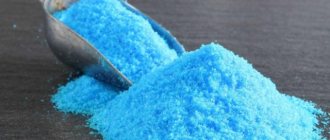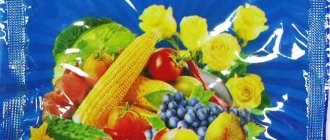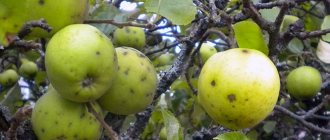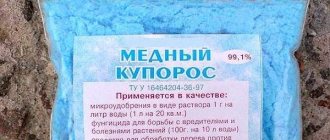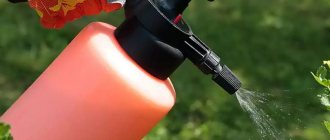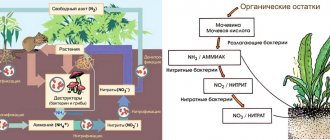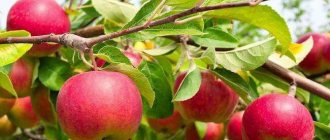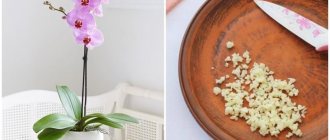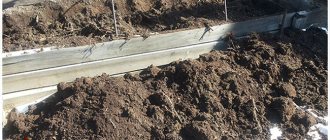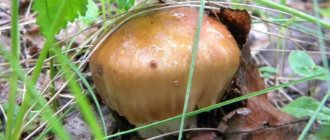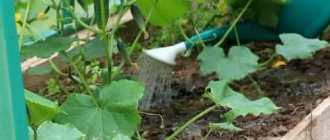Processing by phases
Before the buds open
In addition to iron sulfate, the drug Farmayod can be used to combat lichens.
“Blue” spraying is often recommended against fungal infections, in particular the causative agents of scab and moniliosis on apple trees before bud break.
This is the treatment of apple trees with a 3% Bordeaux mixture. This preparation is obtained by mixing lime and copper sulfate.
After bud break, it is permissible to use only a 1% mixture.
There are also recommendations for spraying with a 1% solution of copper sulfate.
ATTENTION! The period from snow melting to bud break is considered the only suitable period for combating lichens, tinder fungi, and suppressing fungal infections. To do this, spray apple trees in the spring against lichens and tinder fungus with a 5% solution of iron sulfate. To prepare it, you need to dilute 500 g in 10 liters or 50 g in one liter of water
In addition, during this period you can use a 3% Bordeaux mixture
To prepare it, you need to dilute 500 g in 10 liters or 50 g in one liter of water. In addition, during this period you can use a 3% Bordeaux mixture.
Green cone
During this period, the larvae of sucking insects hatch: aphids, copperheads. That is, at this time you should spray with insecticides. Among the chemicals you can use Actellik, Fufanon, Alatar and some other insecticides.
In relatively warm weather - if the temperature is more than 16 degrees, you can use the insectoacaricidal (acting against insects and ticks) preparation of biological origin Fitoverm.
Promotion of green buds
During this period, protective spraying of trees against the apple blossom beetle, as well as with a urea solution against a complex of diseases, is recommended. To make it immediately clear, let us clarify: the apple flower beetle is a harmful insect belonging to the class of beetles, the family of weevils.
Apple flower beetle (weevil).
The following are suggested as protective agents against flower beetle:
- Karbofos;
- Fufanon;
- Pine extract;
- Tansy infusion;
- Lime milk;
- Camomile tea.
At the same time, it is proposed to spray the crown with a urea solution at the rate of 100 g per 10 liters of water.
At the same time, it is recommended to treat the area of the trunk bordering the ground, but for this treatment a more concentrated urea solution is proposed, applied at the rate of 650 g per 10 liters. water.
Pinking of buds
This period is considered dangerous from the point of view of infection with scab and moniliosis (fruit rot). It is at this time that spraying with fungicides against scab and fruit rot is recommended.
Scab on an apple tree.
Moniliosis (fruit rot).
Let us explain: fungicides should be understood as all protective agents used against fungal diseases. Moreover, among them there are both chemical and biological drugs.
Of the chemical fungicides in this case, 1% Bordeaux mixture, Skor, Horus, Abiga-Pik are approved for use.
ADVICE! Among biological preparations, you can use Fitosporin-M and Alirin-B. The latter fungicide is an analogue of Fitosporin-M.
Bloom
During this period, there are recommendations for spraying with various protective agents against copperheads, ticks and aphids.
However, for environmental reasons, including for the sake of preserving beneficial pollinating insects, including bees and bumblebees, in recent years, agronomists have not recommended any spraying against insects during flowering.
That is, protection from sucking insects, especially with chemicals, is best done before or after flowering.
After flowering
Approximately 2 weeks after the end of flowering, repeated treatments against scab, moniliosis, and harmful insects, both sucking and gnawing, are recommended. In particular, in addition to the above objects, treatment against leaf rollers and codling moths will be required.
However, recently, plant protection specialists have recommended choosing time and preparations in such a way as to reduce the number of treatments as much as possible. Therefore, it makes sense to choose a drug immediately against a complex of pests. These products include Fitoverm, which acts on both aphids and honeydews and caterpillars.
Watch a video about the types of spring spraying of apple trees against pests and diseases:
Features of processing apple trees in spring
Scab of apple and pear trees: how to overcome fungus without chemicals
Timely treatment of apple trees in the spring is an important measure that helps get rid of many diseases and pests of trees. However, you also need to know that the war against insects must take place in three stages
The first one usually starts in mid-March (as soon as the air temperature is stable at +5 °C). At this time, the main purpose of treating apple trees is to prevent diseases and destroy pests that have survived the winter, but are still inactive. Before the buds swell, spraying is carried out using chemicals, that is, special fungicides and insecticides. Before direct treatment, it is necessary to trim the crown, clean the trunk of old and dead bark, as well as clean damaged areas and remove foliage remaining from last year.
Did you know? When using chemicals, it is very important to take into account the characteristics of the tree’s life cycle, to know what the growing season of an apple tree is and exactly when it passes (from the beginning of buds to the mass fall of leaves). It’s not worth it to get carried away with processing after flowering, because soon the apples will begin to ripen.
Second phase. In addition, treating apple trees during this period will help you get rid of scab and fruit rot, the problem of which is also very relevant in the spring.
Copper sulfate solution, Bordeaux mixture, colloidal sulfur and Lepidocide (an intestinal biological product that helps cope with gnawing insects) are well suited for spraying.
And finally, the third and final stage of processing apple trees in the spring involves carrying out this activity immediately after the trees bloom. By choosing the right chemicals, you can promptly get rid of leaf roller caterpillars, codling moths, aphids, moths, ticks and weevils. Also, spraying will effectively eliminate emerging diseases. When the flowering period of apple trees comes to an end, it will be possible to repeat the spraying of the second stage
In addition, treating apple trees during this period will help you get rid of scab and fruit rot, the problem of which is also very important in the spring.
Copper sulfate solution, Bordeaux mixture, colloidal sulfur and Lepidocide (an intestinal biological product that helps cope with gnawing insects) are well suited for spraying.
And finally, the third and final stage of processing apple trees in the spring involves carrying out this activity immediately after the trees bloom. By choosing the right chemicals, you can promptly get rid of leaf roller caterpillars, codling moths, aphids, moths, ticks and weevils. Also, spraying will effectively eliminate emerging diseases. When the flowering period of apple trees comes to an end, it will be possible to repeat the spraying of the second stage.
Important! Considering the fact that no treatments can be carried out during the flowering of apple trees, this is the ideal period to start clearing the weeds that appear around the trees.
Chemical protection agents and their use
It is necessary to observe the timing of chemical treatments of the apple tree; they depend on the purpose of the application and the drug used. When spraying on foliage, the recommended doses cannot be exceeded; if the treatment is carried out after leaf fall, you can increase the dose of the drug. It is allowed to use only one of the products on the apple tree.
It is better to use broad-spectrum products to reduce the toxic load on trees. It is not always possible to prepare mixtures in a tank, and repeated treatments can lead to the death of the tree. When choosing a drug, you need to focus on the most pronounced problem and fight it. How to treat apple trees in the fall?
Urea (urea)
Urea is used to treat apple trees throughout the growing season. The concentration of the solution in autumn should be up to 7%, when processing after shedding leaves - up to 10%.
Preparations containing nitrogen cannot be used before leaf fall, as this will reduce winter hardiness. Urea is used when 70% of the leaves have fallen. If there are too many pests, it is necessary to treat the trees and the soil around them. Young trees are sprayed with a 5% solution.
Autumn treatment with urea helps prevent the spread of dangerous pests by destroying larvae and eggs. Spraying is carried out in the evening or on a cloudy day to prevent sunburn. In the fight against aphids, urea is simply irreplaceable.
inkstone
For local treatment, 3% iron sulfate is used; for spraying, a 0.1% solution is used. The treatment replenishes iron deficiency. In autumn, tree trunk circles are additionally treated. The fertilizer helps get rid of black cancer, scab pathogens, and anthracnose.
Copper sulfate
A solution of copper sulfate (1%) is used against mites and pest larvae. The drug is highly toxic. They carry out local treatment of the affected bark on the trunk. Preventive treatments will effectively protect against fruit rot (moniliosis) and scab.
Bordeaux mixture
This is a less toxic analogue of vitriol. Bordeaux mixture consists of copper sulfate 300 and lime dissolved in water. The finished preparation is sold in a specialized store, but some gardeners prepare it themselves, sometimes adding clay instead of lime. If you seriously decide to take up gardening, you need to include the drug in the mandatory list of drugs in your garden first aid kit. Using Bordeaux mixture, you can treat apple trees against scab and other fungal infections. You can use this drug to treat any fruit and berry trees.
Colloidal sulfur
A 1% sulfur suspension is diluted in a large amount of water. The drug is non-toxic until it is exposed to sunlight. Then vapors are formed that poison pathogens and colonies of mites and aphids. The high effectiveness of the drug has been proven in the fight against scab and powdery mildew.
Drug 30+
Preparation 30+ is a contact insecticide. It forms a film on the surface of the insect and also affects eggs and larvae. The film prevents air from penetrating the pest’s body, which leads to its death. It is believed that Preparation 30+ is the best pest control product for use in the fall.
Systemic drugs
Tank mixtures can be made from systemic drugs that can solve several problems at once. Skor, Strobi, Horus, Topaz will help against diseases in the fall. They are used immediately after harvest. The phytotoxicity of the products is minimal, so they can be used without waiting for all the leaves to fall off. Karbofos and Aktara will save apple trees from caterpillars and aphids. You can add them to the fungicide tank.
Fitosporin, Entobacterin, Lepidocide are bactericidal preparations that should be treated on warm September days. The higher the temperature and the sunnier the day, the better. The use of chemicals is not allowed when biological products are included in the fruit tree protection system.
Compliance with all the rules described above will allow you to spray your apple tree in the fall as efficiently and safely as possible. In addition to spraying in the fall, it is necessary to whitewash the bases of skeletal branches and trunks.
Drugs
Formation of a dwarf pyramidal crown of an apple and pear tree
Preventative work against pests should begin in early spring, as soon as the snow has melted. Fungi and parasites multiply most actively in the summer. At this time, the gardener must handle the trees very carefully. The use of highly toxic drugs during fruiting is not recommended. The last spraying is carried out in the fall, when the crop is fully harvested.
At the end of March, the tree bark needs to be treated with urea, because in winter parasites could settle in it. This is one of the most popular drugs. This remedy against aphids also helps, but make sure that the urea does not get on the leaves of the plant during late spring treatment.
Treating apple trees with iron sulfate will help you get rid of scab, moniliosis and other diseases. You can use the drug as a top dressing. Apple trees especially need iron.
Copper sulfate gets rid of fungi, as well as harmful insects. It is used before the buds open.
Bordeaux liquid kills ticks, beetles, and moths. With its help, the apple tree is treated after flowering. It is possible at other times of the year. Scab treatment of apple trees is also carried out using this drug.
Never use drugs in their pure form! Read the instructions to help you dilute the product correctly.
A detailed table will help you understand the processing time and the drugs that are used at one time or another.
Must-Have Fall Activities
Activities to be held in the fall are divided into two types:
- Treating apple trees against pests with chemicals.
- Processing by physical and mechanical means.
The two treatments are carried out in combination; this is the only way they will bring results. Pest control should be intensified immediately after apple harvest. At the beginning of leaf fall, apple trees are sprayed. This must be done before the night temperature drops so that the pests are killed before they fall into deep suspended animation.
Once the leaves have fallen, the trees should be carefully inspected for signs of disease. The trunk and bark of large branches are inspected to ensure there are no signs of black cancer and cytosporosis. If present, local treatments will be required. To destroy spores of brown spot, powdery mildew, and scab, you need to spray the apple tree with fungicides.
Autumn sanitary pruning of apple trees is also required. This is especially important for an adult fruit-bearing garden. Garden pruning should be done after leaf fall. The wintering place of pests and the source of infection are carrion and fallen infected leaves. It is necessary to collect pruned diseased branches and plant debris and burn them. You should not leave collected piles of leaves until spring.
If tinder fungus, lichen and moss are found on the branches, it is necessary to cut them off. They reduce the immunity and winter hardiness of plants and take a lot of strength from the tree. After removing the tinder fungus, the apple trees are treated with copper sulfate (5%). After removing the lichen, the apple trees are treated with iron sulfate (3%).
Whitewashing the trunk and main branches is the final procedure. It allows you to destroy pests hiding in the trunk and protect the bark from cracks. The sun's rays are a big threat in winter; they are reflected from the snow; whitewashing prevents this threat.
All these activities, carried out in full, will fully prepare the apple orchard for winter, reducing the amount of spring work. Healthy apples cannot be obtained without chemical treatment. But you can carry out preventive spraying with chemicals and use physical and mechanical techniques to get an environmentally friendly harvest.
Preparation of Bordeaux mixture
When can trees be trimmed?
It is worth considering that preparing Bordeaux mixture is quite complicated, so everything needs to be done correctly.
Otherwise, the solution may turn out to be too concentrated, and when spraying delicate plants, it will harm them. Or, on the contrary, a weak concentration, then it will not bring the expected effect.
So, let's look at the step-by-step preparation of a 1% solution for 10 liters:
- To dilute the solution, you need to use any non-metallic container.
- You need to dilute 10 grams of copper sulfate in warm water. Everything is thoroughly mixed.
- Next, you need to add cold water to this mixture so that the total volume is 5 liters.
- In a separate bowl, you need to dilute 120-130 grams of slaked lime in 1 liter of water. Mix everything thoroughly and the result should be a mixture with a consistency reminiscent of sour cream.
- Then you need to add water to the lime mass so that the volume is 5. Mix well.
- Strain the lime solution through gauze material. This is necessary to ensure that the sprayer does not become clogged with lime particles.
- Do not under any circumstances confuse what to pour into where! Stirring with a wooden stick or spatula, carefully pour copper sulfate into the lime mixture.
- Everything mixes well. It is advisable to simultaneously stir the lime and pour in the copper sulfate.
The preparation of a 3% solution is the same, only the concentration differs. This solution will require 300 grams of copper sulfate and 400 grams of slaked lime.
Also, after preparation, it is necessary to check the acid reaction of the solution. To do this, insert any metal wire or nail into it. If, after lowering, the metal turns red, then a little more lime should be added to the solution.
Also remember what not to do:
- Do not pour lime mixture into a solution of copper sulfate. This will greatly reduce the quality of the solution.
- There is no need to mix warm and cold ingredients.
- Combine dry ingredients.
- Pour water into the prepared solution.
- Add dry copper sulfate to diluted lime.
When to spray apple trees for pests
Since the pests that most often attack the apple tree have several stages of development, careful treatment of the garden is necessary to achieve the best result.
Timing by growth phases
During the entire season in the garden, treatment takes place four times:
- In early spring on bare branches, before the first buds appear (February - March when a stable air temperature reaches +5 degrees)
- By buds and foliage before flowering (April - May)
- By buds and foliage after flowering (end of May - September)
- Late autumn on bare branches (October - November).
The number of treatments depends on the age of the fruit tree:
- up to ten years, eight is enough;
- from ten to fifteen years – nine;
- more than fifteen years – ten treatments.
Is autumn treatment necessary?
In the overwhelming majority, the main work involved in caring for an apple tree falls in the spring, before the growing season begins. The main task of spring treatment is to destroy fungal defects and parasites that have survived the winter.
But as for autumn treatment, it is needed more as a preventive measure. Autumn treatment is carried out in order to prevent the proliferation of insects - pests that have taken refuge in the bark of a tree for the winter.
At the same time, even if it is not possible to destroy the entire colony of parasites, by spring there will be few of them, which will greatly facilitate the gardener’s work. And the damage from such uninvited guests will be tens of times less if autumn treatment is not carried out.
In general, a procedure such as spraying apple trees in the fall helps to get rid of many problems, from scab attacks to various mites that affect the root system.
So, there is only one conclusion: autumn processing is not only necessary, but also very important. Therefore, you should not ignore it if you want to reap the maximum harvest. But what should be done in the autumn period, read on.
Apple tree treatment in autumn
Competent and timely autumn treatment of apple trees will allow them to survive the winter with minimal losses and actively enter the growing season. The main tasks are to protect trees from frost and prevent pests from overwintering. Cleaning trunks and skeletal branches in late fall will kill most of the larvae found on the bark and in branch forks. Whitewashing will burn away those pests that have taken refuge in cracks and cracks, and will also protect young apple trees from frost damage and burns.
Autumn apple tree
Processing agents
Spraying apple trees in the fall is done with copper sulfate, colloidal sulfur or urea. If the tree has been attacked by insect pests during the summer, it needs additional treatment.
Most often used:
- Horus;
- Karbofos;
- Aktara.
These products will destroy insect larvae and adult insects that have hid in the cracks of the bark and buds for the winter.
In addition to what to treat the apple tree in the fall, you should also add winding material to protect it from rodents and hares. The trunks are tied about a meter from the ground with spruce paws, metal or plastic mesh, and burlap. It is better not to use airtight material - in early spring there is a risk of the bark drying out.
Timing of autumn processing
Spraying with insecticides is carried out after harvesting. And the signal for autumn treatment with copper sulfate or urea is the release of the tree from the main deciduous mass. In each region this time comes differently, approximately the end of October. At the same time, the trunks are cleaned and whitewashed, as well as wrapped with protective material against rodents.
Processing technique
Mechanical treatment of apple trees against pests in the fall is carried out according to the same scheme as in the spring. After cleaning the trunk, the tree and the soil around it are sprayed with antifungal agents, the damage is covered with garden varnish, and whitewash is applied. To do this, you need to choose a dry and relatively warm day for the coating to dry.
Fallen leaves must be raked, burned or buried to a depth of more than 10 cm. You can put them in a compost pit, sprinkling them with lime.
Loosening the tree trunk circles will raise dormant larvae to the surface. Due to the low temperature, they will no longer be able to hide (they are inactive) and will die.
In order to protect against frost and to retain moisture, the tree trunk circles are mulched.
Spraying an apple tree in autumn
When processing apple trees, you should not worry about the harmful effects of chemicals on the future harvest. Using them exactly according to the included instructions will not cause any harm. The substances will disintegrate (including in the soil) before fruit formation begins.
How to spray apple trees and other fruit trees in the fall: rules and recommendations
Before you start autumn gardening, you should familiarize yourself with the basic rules and recommendations:
By the way! Similarly to the apple tree, you can process other fruit trees, as well as berry bushes. But this article lists only diseases of pome crops (apple, pear, quince), which are combated by drugs. However, this does not change the essence of the need for spraying.
- Shortly before the procedure, remove all plant debris (leaves, twigs) from under the trees. If the tree was not sick, then they can be thrown onto the compost heap, but if it was sick, then they need to be burned or buried very deeply.
Don't forget about safety measures. Before spraying, wear a special mask, safety glasses and rubber gloves. It's even better if you wear a special robe.
- The treatment should be carried out on a fine day (in dry and windless weather), and it should be sprayed in the morning so that the bark is dry by the evening. If the rain quickly washes everything away, then spraying will be useless. It is very good if the solution stays on the tree for at least 2-3 days.
Advice! If it rains, and after it they promise the temperature will drop to sub-zero values, then the trees will have to be left without autumn treatment until spring. Unless you suddenly find a “window” with plus and no rain.
- For example, copper and iron sulfate very poorly in cold water, so the sulfate should first be diluted in warm water (40 degrees), and then diluted to the desired concentration with cold water.
Important! Iron and copper sulfate should be diluted or dissolved only in glass or plastic containers, but not in metal ones.
- Do not forget to filter the solution when pouring it into the sprayer (especially if the product is difficult to dissolve). As a rule, you should have a special mesh. If there is no such mesh, then you can strain, say, through tights.
- Autumn spraying of fruit trees should be as thorough as possible, and not only the crown and all branches of the tree should be treated (especially for old trees with cracked bark), but also the soil in the tree trunk. However, you should not treat lawn grass that grows next to a tree (alternatively, you can throw a film on the ground under the tree before processing).
Important! This applies to the use of all means for treating apple trees against diseases and pests in the autumn, which will be listed below.
- It is ideal if during spraying you create a whole cloud of solution, similar to fog.
- If you have conifers growing next to fruit trees, then the treatment must be done very carefully, trying not to get on them, especially if the garden is sick and you are using a strong solution that can burn evergreens.
Note! If you treated the apple tree in the fall, this does not mean that to spray it in early spring - it is still necessary. Autumn eradicating spraying is actually similar to early spring garden treatment (the very first).
Spraying technology
Spraying the garden must be approached carefully. It is not enough to simply buy a pesticide or dilute it yourself
It is also important to select the appropriate equipment with which you can easily process trees
If the apple trees are young or undersized, then a hand-held device with a small pump and a container for liquid is suitable. Tall trees are easier to spray using an automatic sprayer.
The sprayer should release an even amount of concentrate so that the surface is covered with a fine scattering of droplets. The bulk of solutions are prepared immediately before spraying, since due to complex compounds they cannot be stored for too long and therefore lose their effectiveness. During the treatment procedure, the container must be shaken regularly to prevent sediment from forming in the container.
The protective agent should be applied not only to the tree crown and trunk, but also to the soil near the trunk. Treatment should be carried out in the evening in dry, windless weather. There should be about a meter between the sprayer and the surface to be treated so that a large area is irrigated at once.
It is necessary to carry out chemical treatment of the garden using personal protective equipment. You are not allowed to take a smoke break or snack. After spraying, you need to wash yourself thoroughly to wash off any toxins that may have accidentally entered your body.
Fungicides
Fungicidal spectrum drugs are aimed at combating fungal spores. The use of fungicides is advisable not only for treatment, but also for the prevention of diseases. Next, consider the most popular fungicides:
Boric acid
- Boric acid is of great value because its use is universal. Helps seedlings and fruits get rid of the “cork” disease, stimulates the formation of new ovaries and helps get rid of ants.
- Used in liquid form (two tablespoons per bucket of water) to spray the leaf plate.
- In one season, two treatments will be sufficient.
Bordeaux mixture
- Bordeaux mixture is the most accessible and low-cost fungicide.
- The first treatment should be carried out with a three percent solution until buds appear (three hundred grams of copper sulfate and four hundred grams of lime per bucket of water).
- For subsequent treatments (at least five per season), it is necessary to reduce the concentration to one percent (one hundred grams of copper sulfate and two hundred grams of lime per bucket).
inkstone
- For trees to breathe, they need iron, which can only be obtained by using iron sulfate.
- A solution of iron sulfate is applied twice per season - in the spring, before the buds appear, and in the fall, after the leaves fall.
- It is used to treat and disinfect wounds on apple tree bark (half a kilo of vitriol per bucket of water).
- Also effective in the fight against lichen and scab (diluted in the same way).
Copper sulfate
- Copper sulfate solution is universal because it helps not only prevent the occurrence of diseases in the apple tree, but can also rid the garden of some pests.
- Pure copper sulfate should only be used in the garden in early spring.
- To do this, you need to dissolve one hundred grams of blue powder in a bucket of water and spray the trees.
Hom
- Copper oxychloride (CHOM) is a copper-containing fungicide that can protect apple seedlings from various fungal infections.
- It is used during the growing season by spraying (twenty grams per five liters of water).
Horus
- The drug Horus can help in the treatment of scab on apple trees.
- Treatment with this drug is carried out twice per season - before and after the tree blooms;
Fitosporin
You should not neglect biological drugs, for example, Fitosporin. Its use is advisable at any time during the growing season of the apple tree and allows not only prevention, but also cure of any fungal disease. A special difference between phytosporin and other fungicides is its non-toxicity and safety for humans and pollinating insects.
Urea
- You should not be surprised to see urea appear on the list of drugs. It can not only enrich apple trees with nitrogen, but also prevent the appearance of fungal diseases (spotting, scab) and pests (aphids, weevils).
- The use of urea is advisable only in spring and summer, while in the fall there is no need to use the solution.
- The drug is prepared at the rate of half a kilo of urea per bucket of water and is used by leaf spraying.
A mixture of urea and iron sulfate. Solutions for autumn garden treatment
Various preparations are used to spray bushes and trees in the garden. Each of them fights specific pests. Along the way, some help increase the harvest in the future.
The main tools used for processing skeletal branches and trunks:
- urea, a nitrogen fertilizer that destroys insects and arthropods, has a detrimental effect on fungal spores;
- Copper sulfate is a universal fungicide. Pathogenic microflora in the presence of this substance stops development completely;
- iron sulfate is an analogue of copper sulfate, but has another selective effect, destroying a number of types of mold that survive treatment with other fungicides;
- Bordeaux mixture is a complex of different drugs used to protect plants.
You can use any one drug, but it is more effective to create a working mixture of several drugs. Then, with a single treatment, a greater effect is achieved.
Urea (urea)
Urea with (NH₂)₂CO contains up to 46% of assimilable nitrogen, which is one of the three most important preparations for all types of plants. Use solutions with a concentration of 5...7%, preparation: 10 liters of water are diluted with 500...70 g of urea.
(NH₂)₂CO burns away fungal spores, as well as insects and caterpillar eggs. In addition to fertilizing the garden, complete disinfection of the garden is achieved.
In addition to the crown, tree trunk circles are processed. In the spring, the effect of the treatment is manifested, the shoots grow quite quickly in the spring, shrubs and trees quickly put on leaves.
Copper sulfate
CuSO₄ - copper sulfate is used for prevention in the garden and vegetable garden, as well as to destroy putrefactive bacteria. It is detrimental to the pathogenic environment. Treatment with this drug helps get rid of fungal diseases and dangerous types of mold.
In the garden in the fall it is most often used in the form of a one percent solution; for preparation, 100 g of the substance is diluted in 10 liters.
inkstone
Iron sulfate is an antiseptic that inhibits rot, mold and fungal infections. Along the way, it is a fertilizer that provides plants with iron.
With a lack of iron, the leaves begin to turn yellow and the shoots die. Fruit trees (pears, apples, cherries and others) need annual fertilizing in the form of iron sulfate. The treatment will also be useful in the garden; iron sulfate Fe₃ (SO₄)₂ is useful for tomatoes, cabbage, and potatoes.
To remove lichens and moss, treatment with a five percent solution is required. 500 g of Fe₃ (SO₄)₂ are diluted in 10 liters of water. Mix thoroughly until completely dissolved.
Bordeaux liquid
Bordeaux mixture is sold in the form of concentrates. It is effective against many pests. The composition includes: copper sulfate and slaked lime. Spraying such a solution is more difficult. Lime is a colloidal solution that has suspended particles. Therefore, the spray is adjusted so that the nozzles do not become clogged.
Tree treatment in autumn
It is imperative to treat trees in the fall, since this procedure is a necessary measure to prevent the spring invasion of insects, and therefore your yield may also increase.
Around September, insect pests and their larvae begin to accumulate under the bark, in the upper layers of the soil, and under fallen leaves. Thanks to timely digging of the soil and treating trees with chemicals, you can significantly reduce their number.
Immediately after the harvest of apples and pears, the crowns and trunks of trees must be sprayed with a urea solution (400-500 g per 10 liters of water). Urea is an excellent remedy in the fight against scab.
But in order to fight scab and fruit rot, you can also use copper sulfate or Bordeaux mixture.
It is very important that in the fall you properly dig the soil and remove fallen leaves. Some gardeners dig up the soil along with the leaves.
In their opinion, in this way they improve the quality of the soil under the trees. But this opinion is erroneous.
Fallen leaves must be removed and composted to destroy, for example, the spores of clusterosporosis and coccomycosis remaining in them.
The soil itself must be dug up to a depth of 15-20 cm between rows and 10-15 cm around the tree trunk. To prevent damage to the root system, you can use a garden fork by positioning it along the roots.
It is not uncommon for dried and disease-damaged shoots to become overwintering sites for pathogens and insects. As a mechanical control method, these shoots can be pruned and destroyed. But in addition to this, you also need to clean the bark of fruit trees from moss, lichens, dead bark, collect and destroy diseased fruits.
These procedures can help in the fight against spider mites, rust pathogens, powdery mildew, anthracosis, bud moth, shoot gall midge, and currant cushion.
In the autumn, it is necessary to remove and burn the hunting belts, along with the apple moths, weevils and other insect pests that climb there.
As the final stage in pest control, it is necessary to treat the trees with Bordeaux mixture.
The solution is prepared as follows: dissolve 300 g of copper sulfate in 3 liters of warm water. We dilute 400 g of lime in 10 liters of water, stirring constantly, then combine these mixtures (copper sulfate must be poured in a thin stream).
Trees need to be sprayed at the end of October - beginning of November. And it is best to carry out this procedure in sunny, windless weather, trying to process all the shoots and main branches of the trees.
For the spraying itself, you can use a special sprayer with a cylinder in which the mixture will be under pressure.
Treatment with Bordeaux mixture is very useful in the fight against scab, powdery mildew, gray mold, purple spot, coccomycosis and other dangerous diseases.
Spraying with Bordeaux mixture in the fall is also good because you can thoroughly treat your garden, but without causing any harm to beneficial insects.
Also, ovaries or ripened fruits are not treated, which is a pressing problem in spring and summer, when there is a massive emergence of insect pests.
Applications of copper sulfate
For trees
The product is used to treat fruit trees in the garden against infectious diseases and pests that become active in the spring, continue to reproduce in the summer and gain strength before wintering in the fall.
Advantage of use: a small amount of the drug can be sprayed on large garden areas.
For vegetables and shrubs
The main purpose of copper sulfate is to prevent spotting and prevent the spread of harmful insects.
Most often used:
- for tomatoes - with a concentration of 0.2%, treat the underside of the leaves;
- for cucumbers - 50 g of the product, 10 g of urea per 10 liters of water, spraying is carried out until the green mass grows with repeated treatment 1.5 months before the expected harvest date;
- for currants, raspberries and gooseberries - with a proportion of active substance of 0.7%.
Root disinfection
For preventive purposes, the root system is disinfected. The working solution is prepared according to the classical scheme: 100 g of the drug per 10 liters of water.
The dosage for garden and indoor flowers is halved.
Treatments are carried out by root watering and additionally sprayed on the foliage.
Roots and root bulbs are disinfected by immersing them in an aqueous solution with copper sulfate for 2-3 minutes, then rinsing them under running water and drying.
Tillage
The soil is watered with copper and iron sulfate in order to restore the deficiency of the corresponding components in the soil layers. This is required for peat and clay soils to increase their fertility.
The drug also prevents the development of fungi and rot. To disinfect beds before planting, prepare a solution of 300 g of active substance per 10 liters of water.
You should not water the soil with copper-containing liquid in the fall, in preparation for winter. It is better to carry out the procedure in the spring.
In order to increase soil fertility, dry powder is added once - 1 g/m². You can dilute the working fluid with a small concentration of the active substance - up to 30 g per 10 liters. This fertilizer is enough for the plot for the next five years.
Other areas of application
Copper sulfate serves as a good antiseptic and is often used when treating wooden structures and metal structures.
the positive result of the procedure lasts for 5 years. The required concentration is 1%.
Technology:
- on metal structures, the solution is applied with a paint brush to damaged surfaces;
- wooden parts are soaked for 48 hours, then dried in the open air for a month;
- freshly sawn sections of wood are immersed in vitriol for several minutes as a preventive measure against harmful insects and mold.
How to treat apple trees in spring
First of all, an apple tree growing in a summer cottage must be rid of infected branches and areas of bark and everything must be burned so as not to spread the infection. After this, all wounds remaining on the tree are treated with a solution of copper sulfate, and then with garden pitch. Next, garden whitewash is applied to the trunk, which can protect against infection and some overwintered pests. Now you can start spraying the trees.
As a rule, wood processing alone is not enough. It is best for the process to have three processing steps:
- until the buds swell
- during the period of kidney swelling,
- after flowering.
The first stage usually occurs in March, when the tree is still dormant and the air temperature is no less than +5 C. During flowering, there is no need to spray apple trees, since bees will not be able to pollinate. Processing is best done in the afternoon. It would be nice if there was no wind or rain during this period. So what do you spray trees with in the spring? Let's look at the most effective methods.
Why spray apple trees with copper sulfate?
Experienced gardeners know well how difficult it is to cure a fruit tree affected by a particular disease or insect pest. This is a long and troublesome process that does not always end with the recovery of the plant. That is why it is recommended to pay special attention to preventive measures aimed at preventing damage by spores of pathogenic fungi and the proliferation of pests. In particular, we are talking about spraying an orchard with a solution of copper sulfate. Its active ingredient - copper sulfate - has an antiseptic effect and helps fight anthracnose, moniliosis, spotting and scab of apple trees, and also expels codling moths and mites from the bark.
Reference. When sprayed in early spring and late autumn, up to 70% of larvae and adults hiding for the winter, as well as mycelium and spores of fungi, die.
When to spray apple trees against pests and diseases
Experienced gardeners use fungicides to combat diseases, and insecticides to protect against pests.
Spraying against diseases (prevention)
Scab, fruit rot and other diseases of apple trees bring a lot of trouble to gardeners. Signs of diseases are especially often observed on young trees. It is quite difficult to remove pathogens, so it is easier to prevent infection by spraying the apple tree 4 times a year. Preventive treatments are carried out during the following periods:
- In February or early spring until the leaf buds swell (the average daily ambient temperature should rise above +5 degrees).
- Before flower buds swell and bloom on trees (April - May).
- Once after flowering (from late May to September).
- After the leaves fall along bare branches (October - November).
The first spraying is carried out until the buds open.
As can be seen from the list, after flowering until autumn, apple trees are treated only once for preventive purposes. However, if the apple tree still gets sick or suffers from pests, the gardener no longer carries out preventive, but therapeutic treatments until the signs of infection disappear.
In total, during the period from May to September, it is permissible to carry out no more than 3 treatments with strong garden chemicals. Biological products (Fitosporin, Fitoverm) are used more often.
If there are no signs of infection on the apple tree, 4 treatments per year are sufficient for young trees. Healthy trees older than 5 years are treated twice: in early spring before leaf buds bloom and in late autumn (the first and last treatment on the list).
During the ripening period, therapeutic treatment of apple trees is possible, but if you are not using biological products, then the last therapeutic spraying should be carried out at least 20 days before harvesting the fruits.
Spraying against pests
Preventive spraying against pests is also carried out within the established time limits; they approximately coincide with the time limits for fungicide treatments:
- in February or early spring until the leaf buds swell (the ambient temperature should rise above +5 degrees);
- before flower buds swell and bloom (April - May);
- after the leaves fall along bare branches (October - November).
Pest control is best done after spraying with fungicides. The interval between treatments should be at least 2–3 days.
Therapeutic treatments are carried out in case of pests appearing on apple trees. As a rule, modern preparations require a single spraying to treat the garden. In the instructions for the chosen product, be sure to look at when and how often it should be used.
Means and methods for treating apple trees against diseases
To combat various diseases and pests affecting fruit crops, appropriate methods of prevention and treatment have been developed.
Treatment of moniliosis
This tree disease is caused by fungal spores carried by insects that pollinate the blossoming buds. Under the influence of fruit rot, the branches and foliage of apple trees look scorched. To treat plants for moniliosis, infected parts of the tree are removed and burned. The affected apple tree and the trees adjacent to it are sprayed with antifungal compounds. The following have proven themselves well in this regard:
"Abiga Peak";
- "Topsin";
- "Horus";
- "Kuproksat";
- copper sulfate.
Fungus treatment
If untreated cuts or broken branches are found on the apple tree, this indicates that the tree may be infected with mold.
To prevent the development of the disease, damaged areas of the bark should be cleaned with a thick brush, and damaged branches should be trimmed. Treat cleaned areas with fungicides. In addition, it is necessary to whitewash with slaked lime. Treatment will give a positive result only at the beginning of the disease. And after the fungus penetrates the cambium, the entire tree will gradually die.
From lichen and moss
Apple trees are cleaned of lichens and moss only in late autumn. Before processing, the crop must already be harvested and fallen leaves removed from the garden. The branches are treated with a solution of iron sulfate, the effect of which lasts a week. After this period, mosses and lichens are carefully cleaned from the trees. Damaged areas are covered with garden varnish. After another week, it is necessary to repeat the treatment, spraying the ground next to the tree. Complete the cleaning with whitewashing.
Bacterial and viral diseases
Bacterial microorganisms can cause peculiar burns that affect the tissues of the apple tree.
Microbes that enter the tree through damage to the bark accompany moniliosis. The cause of infection can be insects. To combat such diseases, broad-spectrum antibiotics are used. At the same time, insects carry viral diseases, for example: mosaic, witch's broom, star cracking of apples and much more. Once in the wood tissue, viruses become a catalyst for the process of their degeneration into malignant formations.
Currently, there is no specific treatment for viral diseases of apple trees, so it is necessary to destroy identified foci of the disease. Phytohormones are used as prophylaxis.
Processing process
Previously, various products were diluted in a bucket of water and applied to the trees using a broom. Some gardeners use spray bottles. Today there are many other handy tools that help against pests.
In specialized stores you can purchase pumps, electrical systems, and innovative sprayers. It all depends on your capabilities.
Stand in front of the tree at a distance of 75-100 cm (focus on the power of the pump). Spray the trunk, all shoots and even the leaves evenly. Avoid processing during fruiting period. If the tree is heavily infested, try not to get it on the apples.
Treat all trees at the same time to prevent re-infestation.
After each pruning, the apple tree cut is processed. Cuts of young trees need to be lubricated after a few days, when the wound has dried out a little. To do this, take potassium permanganate and dilute it with warm water until it turns bright pink. You can dilute 30 grams of iron sulfate in one liter of water. Treatment of circular wounds of apple trees also occurs with the help of 50 grams of copper sulfate. After disinfection, the sections are treated with garden varnish or oil paint.
How do selected drugs affect the treatment schedule?
To spray apple trees, you can choose one of the effective preparations with funcicidal and insecticidal properties.
Urea (urea)
Urea not only enriches the soil with nitrogen, but can also be used as a fungicide and insecticide. It is effective against diseases (spotting, scab) and pests (aphids, weevils). It can treat trees no more than 6 times per season. At least 10 days must pass between treatments. To prepare the working solution, dilute 500 g of urea in a bucket of water (10 l). The resulting composition is sprayed on trees on leaves or buds.
Urea is best used for preventive purposes, as well as when the disease is at an early stage. If the apple tree shows extensive signs of damage, it is better to choose a more potent insecticide or fungicide.
Since apple trees do not need excess nitrogen during the ripening period and in the fall, most gardeners prefer to use urea for the first spring treatment.
Bordeaux mixture (mixture)
Bordeaux mixture is one of the cheapest, yet effective fungicides. The drug is a mixture of solutions of slaked lime and copper sulfate. You can also purchase a ready-made Bordeaux mixture, which you only need to dilute with water. In the spring (in the first and second spraying) a 3% solution is used to treat apple trees, and in the fall - a 1% solution. It is prohibited to spray the product several times on the same place. You can return to the garden only after 6 hours after treatment. Spraying is best done in the morning or evening hours in calm and dry weather. It should not be too hot outside, as this increases the risk of “burning” the plants.
Bordeaux mixture is an effective means for spraying apple trees
I always treat the apple trees in my garden with Bordeaux mixture or urea. You can alternate them so that you get 2 treatments with each drug per year. I use strong chemical fungicides and insecticides only if the trees are infected.
Decis
Decis is a broad-spectrum insecticide. It is especially good to use against leaf rollers and codling moths. Decis is a toxic drug. In order not to harm the crop and not increase pest resistance to it, it is recommended to carry out no more than 2 treatments per season (in early spring and autumn). If this is not enough, you can alternate the product with other insecticides.
To prepare a working solution, you need to dilute 1 g of powder in 10 liters of water and mix well, and then spray the trees. The last treatment must be carried out no later than 3 weeks before harvest.
Alatar
Alatar is a powerful industrially produced insecticide. It is effective in the fight against codling moths, aphids, leaf rollers, and moths. To prepare a working solution, you need to dilute 5 ml of the drug in 5 liters of water. The specified amount of solution should be enough to treat an adult tree.
Alatar is also considered a toxic drug, so the last treatment must be carried out at least a month before harvest (it is better to use this product in early spring and autumn).
Spraying apple trees against pests and diseases must be carried out in several stages. For preventive treatment, safer drugs are chosen (urea, Bordeaux mixture). If pests are suddenly detected, you can spray the trees unscheduled, but you still need to focus on the time limits allowed for this.
Spraying apple trees with urea in the fall. Urea
Urea (urea) is carbonic acid diamide, colorless or white crystals, soluble in water.
In agriculture, it is primarily a supplier of nitrogen. Urea has high chemical activity and is well absorbed by plants during processing. Urea in high concentration can be used to protect trees from diseases and pests. Apple trees need to be treated in early spring and autumn, after leaf fall. A concentrated solution applied during the growing season will burn the leaves. For foliar feeding, urea is used by diluting a small amount of the drug in water.
Treating apple trees with urea in the fall will help:
- in the fight against diseases and pests;
- to treat fallen leaves against larvae of pests and pathogens overwintering in them;
- increase the winter hardiness of the apple tree;
- to slow down the start of the growing season.
Fallen leaves are processed in the fall when they are not removed from the site for one reason or another. Then the solution is made with a concentration of at least 10% and sprayed generously, turning the litter from time to time with a pitchfork or rake. Urea will simply burn the larvae and spores of diseases, and by spring the leaves will rot and become additional fertilizer for the apple tree.
Treatment with urea will help in the destruction of pests of apple trees and other fruit crops:
- aphids;
- weevil;
- copperheads;
- apple blossom beetle.
Using urea treatment you can fight diseases:
- monilial burn;
- scab;
- purple spotting.
You can treat an apple tree that has lost 70% of its leaves. In this case, the concentration of the working solution should be within 5-7%. But it is better to treat in late autumn, when the apple tree has completely shed its leaves. Then you can spray the tree, tree trunk and fallen leaves with a 10% urea solution (which will be more effective).
Important! Young apple trees under 5 years of age must be treated with a 5% solution.
Before spraying in the fall, you need to prune, it is advisable to remove plant debris. If necessary, strip the bark from old trees.
It is necessary to treat apple trees in the fall against pests and diseases in calm weather, on a cloudy day at a temperature of at least 5⁰ C.
Important! You cannot combine urea with chalk and lime.
